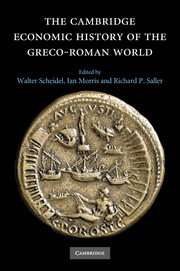Book contents
- Frontmatter
- 1 Introduction
- Part I Determinants of Economic Performance
- Part II Early Mediterranean Economies and the Near East
- 7 The Aegean Bronze Age
- 8 Early Iron Age Greece
- 9 The Iron Age in the Western Mediterranean
- 10 Archaic Greece
- 11 The Persian Near East
- Part III Classical Greece
- Part IV The Hellenistic States
- Part V Early Italy and the Roman Republic
- Part VI The Early Roman Empire
- Part VII Regional Development in the Roman Empire
- Part VIII Epilogue
- Bibliography
- Index
- Map 1.1 The Mediterranean basin"
- Map 10.1 Greek and Phoenician trade in the period of the Persian Wars"
- Map 11.1 The Achaemenid empire"
- Map 12.1 Greece and Asia Minor"
- Map 15.1 The Seleucid empire"
- Map 16.1 Greco-Roman Egypt"
- Map 20.1 The Roman empire at the accession of Vespasian"
- References
10 - Archaic Greece
from Part II - Early Mediterranean Economies and the Near East
Published online by Cambridge University Press: 28 March 2008
- Frontmatter
- 1 Introduction
- Part I Determinants of Economic Performance
- Part II Early Mediterranean Economies and the Near East
- 7 The Aegean Bronze Age
- 8 Early Iron Age Greece
- 9 The Iron Age in the Western Mediterranean
- 10 Archaic Greece
- 11 The Persian Near East
- Part III Classical Greece
- Part IV The Hellenistic States
- Part V Early Italy and the Roman Republic
- Part VI The Early Roman Empire
- Part VII Regional Development in the Roman Empire
- Part VIII Epilogue
- Bibliography
- Index
- Map 1.1 The Mediterranean basin"
- Map 10.1 Greek and Phoenician trade in the period of the Persian Wars"
- Map 11.1 The Achaemenid empire"
- Map 12.1 Greece and Asia Minor"
- Map 15.1 The Seleucid empire"
- Map 16.1 Greco-Roman Egypt"
- Map 20.1 The Roman empire at the accession of Vespasian"
- References
Summary
introduction
The Greek world of the seventh and sixth centuries differed markedly from the Greek world of the ninth and eighth centuries. Scholars have talked of a structural revolution in the eighth century. For the economic historian the dramatic changes come later and concern both structure and performance.
Some of the changes were slow, important for their cumulative impact rather than making a marked difference in the short term. Population is one case in point. Except for slaves, where there may have been a sharp increase in numbers in some cities in the sixth century, population grew at a rate of perhaps 0.5 percent a year. Such a growth rate would have more than doubled the population during the period in question, but given a high degree of population mobility, few at the time would have perceived clear change. Population growth itself entails and stimulates growth in consumption and production. Distribution of fine pottery and of quality housing suggests per capita as well as aggregate increase in consumption. And although the conditions of agricultural production did not alter significantly, with climate likely to have been more or less constant and no signs of significant advances in agrarian technology, the spread of Greeks to environments more favorable for agriculture than the Greek mainland and Aegean is likely to have increased per capita agricultural production also. Outside agriculture, too, much technological change seems to have been more a matter of degree than of kind: iron had already established itself as the dominant “working metal” by 700, ship-construction methods do not seem to have altered, technical developments in pottery are primarily linked to decoration, not to productivity.
- Type
- Chapter
- Information
- The Cambridge Economic History of the Greco-Roman World , pp. 277 - 301Publisher: Cambridge University PressPrint publication year: 2007
References
- 12
- Cited by



